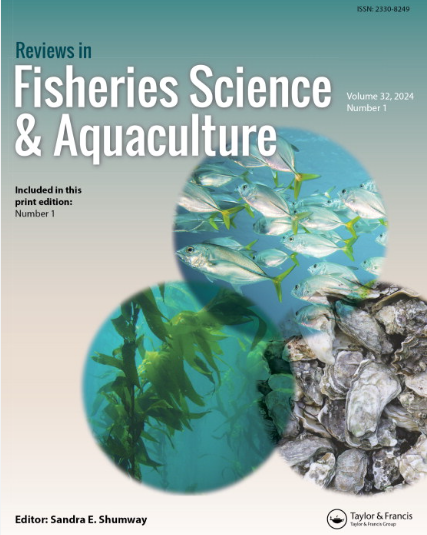水培系统工程设计“,
IF 5.3
1区 农林科学
Q1 FISHERIES
引用次数: 13
摘要
摘要水培是水产养殖和水培的结合,在无土养殖中生长的植物通常在受控的环境中利用鱼类生长释放的营养物质。与传统水产养殖相比,水产养殖的潜在优势包括提高可持续性、减少资源消耗和减少环境影响。根据2014年的一项调查,发现大多数受访者将水培作为一种爱好。其他受访者群体包括教育工作者、经营水产养殖系统的非营利组织、商业运营商以及销售商品、材料和服务的顾问。尽管许多支持者认为有机会建立一个商业上可行的食品生产系统,但很少有(如果有的话)企业表现出可持续的财务成果。总的来说,尽管一些研究人员做出了努力,但许多同行评审的水培出版物和流行文献都缺乏系统的科学基础来描述水培系统中的基本机制、关系和培养方法。许多系统是由试错法设计的小规模实验设施演变而来的,并在当地有限的适当物种、有限的资金和扭曲的市场状况下实施。许多已发表的水培实验都是基于小型系统、短期生长试验和薄弱的实验设计。主要的系统设计方法是基于相对较少的实验。这篇综述介绍了符号和算法,旨在标准化水产养殖中的许多关键值,以确定设计标准和操作参数,包括流量、水质成分的浓度、代谢产物的产生以及水产养殖系统中动植物部分的生产力。这种系统方法的目标是采用科学方法,提供可以复制、挑战和改进的研究结果。这种方法有望促进科学信息、生产系统和合理经济应用的更快发展。这种方法对于商业应用至关重要,因为在商业应用中,生产成本、产品价值和投资回报对设想投资新企业的从业者至关重要。对于爱好者和教育工作者来说,经济问题可能不如自给自足和自然协同作用、个人满意度以及现有最先进的水培实践所带来的学习体验那么重要。这些结果仍然适用于所有人,对较小的个人系统的更清晰理解可能会得到加强。本文章由计算机程序翻译,如有差异,请以英文原文为准。
Engineering Design of Aquaponics Systems
Abstract Aquaponics is the integration of aquaculture and hydroponics where nutrients released by growing fish are utilized by plants grown in a soilless culture, often in a controlled environment. Potential advantages of aquaponics include improved sustainability, reduced resource consumption, and fewer environmental impacts compared to conventional aquaculture. Based on a 2014 survey, it was found that most respondents were practicing aquaponics as a hobby. Other groups of respondents were educators, non-profit organizations that operate aquaponic systems, commercial operators, and consultants that sell goods, material, and services. Although many proponents cite the opportunity to create a commercially viable food production system few (if any) ventures have demonstrated sustainable financial outcomes. In general, much of the peer-reviewed aquaponic publications and popular literature, and despite the efforts of some investigators, lacks a methodical scientific basis for describing the essential mechanics, relationships, and culture methods within aquaponic systems. Many systems evolved from small-scale experimental facilities devised by trial and error methods and were implemented with locally limited appropriate species, limited finances, and distorted market situations. Many of the published aquaponic experiments are based on small systems, short growth trials, and weak experimental design. The predominant system design approach is based on a relatively small number of experiments. This review introduces notation and algorithms that are intended to standardize the numerous critical values essential in aquaponics for purposes of determining design criteria and operational parameters including flows, the concentration of water quality constituents, metabolite production, and productivity of plant and animal segments in an aquaponic systems. The objective of this systematic approach is to employ scientific methods that provide research results that can be replicated, challenged, and improved. This methodology is expected to facilitate more rapid development of scientific information, productive systems, and rational economic applications. This approach is crucial for commercial applications where production cost, product value, and investment returns are of critical importance for practitioners that envision investment in new ventures. For hobbyists and educators, economic issues may not be as important as the self-sufficiency and natural synergism aspects, personal satisfaction, and the learning experience that result from existing state-of-the-art of aquaponic practices. These outcomes remain for all and a clearer understanding of smaller personal systems is likely to be enhanced.
求助全文
通过发布文献求助,成功后即可免费获取论文全文。
去求助
来源期刊

Reviews in Fisheries Science & Aquaculture
FISHERIES-
CiteScore
25.20
自引率
0.90%
发文量
19
期刊介绍:
Reviews in Fisheries Science & Aquaculture provides an important forum for the publication of up-to-date reviews covering a broad range of subject areas including management, aquaculture, taxonomy, behavior, stock identification, genetics, nutrition, and physiology. Issues concerning finfish and aquatic invertebrates prized for their economic or recreational importance, their value as indicators of environmental health, or their natural beauty are addressed. An important resource that keeps you apprised of the latest changes in the field, each issue of Reviews in Fisheries Science & Aquaculture presents useful information to fisheries and aquaculture scientists in academia, state and federal natural resources agencies, and the private sector.
 求助内容:
求助内容: 应助结果提醒方式:
应助结果提醒方式:


